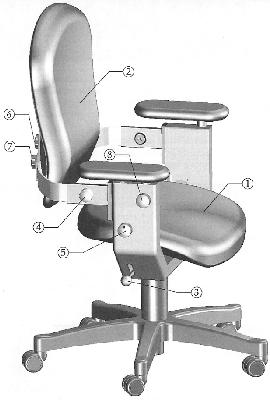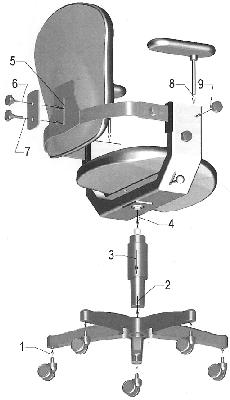Wednesday, 20. July 2011
In the quest for a chair that feels comfortable for 8+ hour days of computer usage, I stumbled on reviews of SmartMotion Technology's SwingChair and decided to try it because of the unusual concept of a chair without seat/seatback tilt locks. It's one of the few chairs I think would work well for people who are sitters and perchers.
Perchers vs. Sitters
The distinction between sitter and percher is important because what works for one may not work for another. If you're a "sitter", you lean back against the chair when working. If you're a "percher", you lean forward and sit towards the front of the chair when working. Chairs for a latter are harder to find because most seat designers don't design their chairs so they're comfortable for perchers (for best ergonomics, you're not support to perch because it's bad for your neck). In my case, I tend to perch if I do any graphics editing or anything else on the screen I need to intensely concentrate on. To prevent lower back ache and pressure on my lower regions while perching, I have to tilt the front seat slightly. When I sit back, I have to tilt the seat back to a normal setting of nearly horizontal.
SwingChair Lever-Less Design
The first thing you'll notice about the SwingChair is that there are no levers to adjust the seat or back tilt. There are only a few knobs to adjust the tilt tension, back depth/height. The reason is the seat and back of the chair adjust with you as you move around:

It does this by using your natural leg tension with the floor to help control the relative angles of the back and seat. Because of this, it's important to get the height between your thighs and your feet (they also sell an adjustable foot rest if you need to get more height to match your desk keyboard height). If you're too low, your seat angle will be upwards most of the time. If you're too high, your seat will be tilted downwards and you'll feel like you're sliding down.
This is an essential part of the SwingChair design (there is no "lockup" mode to the tilt tension dial for those who really hate this feature). It's what lets your back feel better by not locking your body into a fixed position.
Adjustments
| As mentioned, there aren't that many adjustments needed. Most involve simple to use knobs. The lever (a very solid metal rod with a ball on the end) to adjust the seat height is the only thing it has in common with most chairs. The two (4) knobs on both sides let you slide the seatback rearwards (I didn't need to adjust it and I'm a fairly average 5'9" with a thin frame). You can adjust the (5) knobs to adjust the recline resistance to one of four positions. You can use knob 6 to adjust the height of the seatback (I left mine at the bottom). And finally you can use knob 7 to adjust the tilt of the seatback, but not very much (maybe 5 degrees?). |  |
The design of the armrests is clever in that the rod is offset so that you can set to closer to the body or forward if you'd like (depending on which side you put thar armrest on) because the rod is offset and you can put the armrests on either side facing forward or back.
 Assembly
Assembly
| After having assembled a few chairs from box stores and mail order, I was pleasantly surprised to see how simple it was to assemble the SwingChair. The swing mechanism and the seat come assembled as one unit; it would have been painful to assemble because of the screws underneat the seat. The rest of the assembly doesn't require any hex wrenches or screwdrivers; nearly everything uses knobs with threads: |  |
Areas of Improvement
Unfortunately, not all is perfect, but most things are not and have areas for improvement, and the SwingChair is no different.
The biggest difficiency for me is that the armrests rotate when I push against them to get up. This problem seems to be that the only way that the armrest is prevented from rotating is the end of the bold resting against a cylindrical rod; I can tighten the knobs enough to gouge the rods but the armrests still rotate. You can see the knobs and armrest bolt below:
SmartMotion was nice enough to send a few extra knobs to see if that would help, but unfortunately there was no difference (didn't think it would because the knobs didn't bottom out yet). Changing the rod to a hexagonal rod should fix this issue since that will give the bolt a flat surface to push against.
Another minor nit is the fit/finish of a piece of trim at the at the bottom of the seatback. It looks like it was cut too short or not glued in properly. It's something I'd expect to see in inexpensive office chairs you'd find at Staples:

Last minor knit is the cover for the hydraulic piston. It's the same cheesy (thin/plastic) cover that is used by office chairs you assemble from Staples. It's a very minor thing that people wouldn't notice if the chair came pre-assembled, but the rest of the chair has a higher level of sturdiness feel except for this part:

The chair legs themselves are more rectangular than other chairs I've tried, so I've stubbed my toes against them more than with other chairs (yes, this sounds weird). Rounded legs would make this a lot better.
Conclusion
This might sound like a lot of issues, but they're minor compared with the overall functionality of the chair which I'm quite happy with. The only other thing I'd want is some sort of mesh seat with a steep front lip falloff for those summer days when it gets humid and 85F+. The foam does not seem to retain heat as much as other foams but does retain some heat.
I've had the chair for a few weeks now and it took maybe a week to adjust to the swing feature. It's more comfortable for my lower back than regular chairs. I'll update this again in a few months if anything changes, but now, my chair search is over.
Other Chairs Tried
For those curious about my chair search journey, I thought it might be interesting to list chairs I've tried before arriving at the SwingChair:
- Generic office chair with all the tilt/height (seat, seatback, chair height) settings recommended for an ergonomic chair: the foam was too warm (it was 10 years old, so it predated tempurpedic foam) and I ended up with sweaty rear syndrome in the summer
- Aeron chair with tilt/lumbar adjustments: this popular (but expensive) mesh chair was great for keeping you cool in the summer, but the deficiency is the front lip of the seat which will cut off your leg circulation if you are a percher.
- Costco office chair (can't remember brand): felt ok in store but way too hot when sitting for a while (vinyl pseudo-leather seats) and no seat tilt adjustments meant it cut circulation off
- Pro Line II Air Grid chair with tilt/height adjustments: way too wide and seat tilt adjustment didn't work but back mesh was comfortable